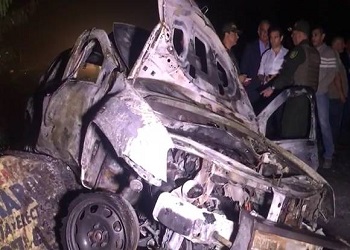A recent series of deadly attacks against police in Colombia attributed to the Gaitanistas hasn’t stopped authorities from trumpeting their successes against the criminal group, despite evidence of the Gaitanistas’ persistent strength.
The Gaitanistas criminal group, the most powerful in Colombia, is accused of having orchestrated yet another attack against Colombian law enforcement, resulting in the death of a police officer in the Caribbean city of Acandí in the department of Chocó, reported Caracol Radio on May 8.
According to the news outlet, two other police officers were killed within a span of a week in the neighboring department of Antioquia.
In addition, a police commander was murdered in the northern city of Valledupar on May 5. Authorities stated that the alleged attacker, who was killed during his arrest, was a member of the Gaitanistas, also known as the Gulf Clan, Urabeños, and Gaitanist Self-Defense Forces of Colombia (Autodefensas Gaitanistas de Colombia – AGC), according to El Colombiano.
The spate of murders of police officers stretches back to March and has in part been attributed to the National Liberation Army (Ejército de Liberación Nacional – ELN) rebel group. But authorities have also argued that the most recent murders have been retaliation on the part of the AGC for security operations against the group.
Since February 2017, at least three high-profile figures of the criminal organization have been killed during police operations, and a fourth was arrested in Medellín, reported El Colombiano in a separate article.
On May 3, shortly after the third death of a high-ranking AGC figure, a police patrol responding to an emergency call in the San Cristóbal area near Medellín was attacked with an explosive device that was thrown inside the police vehicle. Two officers were injured in an act that was described as part of the criminal group’s retaliatory actions.
SEE ALSO: Urabeños News and Profile
Meanwhile, on May 6, authorities held a ceremony to congratulate police officers who participated in “Operation Agamenón,” reported Radio Sante Fe.
The operation, launched in February 2015, led to the deployment of significant firepower, including military helicopters and bombardments of camps, with the aim of destroying the AGC in their traditional stronghold, the Caribbean Urabá region, which is used as a launchpad for cocaine shipments. One of the explicit objectives from the start was the capture of the criminal group’s top leader, Dario Antonio Usuga, alias “Otoniel.”
Authorities list among the operation’s successes the capture of more than 1,000 suspected AGC members and the seizure of 44 metric tons of cocaine, according to Radio Sante Fe.
General Jorge Hernando Nieto Rojas, the head of Colombia’s National Police, asserted that the criminal organization “has been dismantled by more than 50 percent.”
InSight Crime Analysis
The number of AGC members reportedly captured during Operation Agamenón as well as the large seizures of cocaine suggest that authorities have succeeded in delivering some blows to the criminal organization. In addition, the pressure from the long-running operation appears to be one of the explanatory factors for the group’s attempt to take over trafficking routes in the Chocó department.
Still, the Colombian government’s assertions that their efforts have significantly weakened the AGC deserve close scrutiny. Various signs, including the string of recent attacks against police officers, indicate that the group continues to wield significant criminal power. In fact, reports have indicated that the AGC have been extending their reach, including along the country’s Pacific Coast and in Putumayo along the border with Ecuador.
SEE ALSO: Colombia News and Profiles
And while the government boasts about the large volume of cocaine seizures, the size of these busts actually points to the organization’s continued strength.
Moreover, nearly two years after the start of Operation Agamenón, authorities have yet to capture Otoniel. In other words, the initiative has so far failed to achieve its prime objective. The AGC’s leader has so far evaded capture and remains at large.

